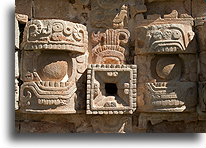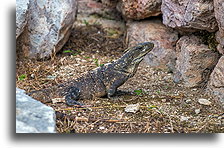Long-nosed God Chaac
October 13
Reaching our next destination late in the evening, when it is already completely dark, has become our tradition. In fact, this is not difficult to achieve, because the sunset in this part of the world occurs no later than 7 PM. We asked people here and there and we were allowed to camp next to the ruins of Uxmal. The famous Pyramid of the Magician was surprisingly close.


A visit to Uxmal, the Maya archaeological site on the Yucatan Peninsula, was the most expensive of all 20 such places we have visited in Mexico so far. At the ticket office, we were asked to pay an admission fee three times higher than usual. There was no choice. Uxmal is one of the five most important archaeological sites of the Maya culture along with Palenque and Calakmul we visited recently.
Uxmal was the capital of the region. At the peak of its development, the city had about 25 thousand inhabitants. Supporting such a large population was not a small challenge because there are no permanent water sources in the area. There are no rivers here, no springs, or wells. To collect rainwater, the Maya built underground stone chultunes, bottle-shaped underground storage cisterns, or drilled aguadas, hollows in the ground. When such tanks became useless, they were often used for human burials. According to Maya beliefs, the underground cisterns could be considered closer to Xibalba or the Underworld.




Probably the most famous in Uxmal is the Pyramid of the Magician. It is also the tallest structure here. The pyramid, as it stands today, is the result of five different construction periods from the 6th to the 9th centuries. It was a common practice in Mesoamerica to build new temple pyramids atop older ones in order to gain greater height and increase volume. Among the many Mesoamerican pyramids, this one at Uxmal is unique. The pyramid is different because of unusual elliptical shape and the rounded sides. Two architectural styles are visible here. Smooth wall surfaces, long-nosed masks, and styling along horizontal lines are the features of the Puuc architecture. Temple doorways surrounded by a single mask are typical of the Chenes design.




Another important structure in Uxmal is the Governor's Palace, a long building standing atop a huge platform. This building has the longest façade in ancient Mesoamerica, 98 m/ 321 ft. The orientation of the building related is to the location of Venus in its extreme northern position. This is why the building's decorations contain hundreds of Venus glyphs. Governor's Palace, which was probably a royal residence, is the finest example of the Puuc style.





A ballcourt can be found in many ancient Mesoamerican cities. Across the region, different cultures developed many rules of the game, always played with a solid rubber ball. The Maya placed vertical stone rings on each side of the court. The object of the game was to pass a heavy ball through one of them, only touching it with hips, elbows, and knees. There is a connection between this game and human sacrifice. Sometimes captives were sacrificed, sometimes the ballplayers, including winners.


Not far from Uxmal located are other interesting Maya ruins, Kabah. We went there in the afternoon mainly to see the "Palace of the Masks.” The façade of this palace decorated is with hundreds of stone masks of the long-nosed rain god Chaac. The fabulous effect achieved was by the massive repetition of the same set of elements. This is unusual in Maya art.





To see the glorification of a single god at such a scale, it is impossible not to ask the question why the rain god was so important for the Maya living in this region. Well, to survive, the inhabitants of Kabah relied solely on rainwater; this is because the area has no sources of drinking water. The favor of the rain god was extremely important for existence. God Chaac used to strike the clouds to cause thunder and much needed rain.






The monumental Arch of Kabah dates from the 8th century AD. Its simple decoration emphasizes the importance of the opening, the beginning of the sacbe, the paved road connecting Kabah with Uxmal. Maya built a whole network of such roads connecting many different cities and regions. After the Spanish colonization, many ancient sacbes became the basis for modern roads.


On our way back, we stopped in Santa Elena. We were intrigued by a church that dominated the area. Probably Franciscans started conversion to Christianity in this region. This is why San Mateo Church was erected. Without windows, it looks like a medieval fortress. It is a typical colonial church style in Mexico. Protection from the attacks of indigenes population was required. In the early 1840s, the explorer John Lloyd Stephens and his travelling companion artist Frederick Catherwood used this small community as a base to explore the Puuc area and places like Uxmal and Labna. Investigating 44 ruins in total, they pioneered in the study of Maya civilization.















